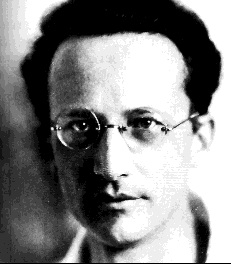Order, Disorder and Entropy
This is a rather subtle line of thought, open to misconception in more than one respect. All the remaining pages are concerned with making it clear. A preliminary insight, rough but not altogether erroneous, may be found in the following considerations:
It has been explained in Section I that the laws of physics, as we know them, are statistical laws. They have a lot to do with the natural tendency of things to go over into disorder.
But, to reconcile the high durability of the hereditary substance with its minute size, we had to evade the tendency to disorder by ‘inventing the molecule’, in fact, an unusually large molecule, which has to be a masterpiece of highly differentiated order, safeguarded by the conjuring rod of quantum theory. The laws of chance are not invalidated by this ‘invention’, but their outcome is modified.
The physicist is familiar with the fact that the classical laws of physics are modified by quantum theory, especially at low temperature. There are many instances of this. Life seems to be one of them, a particularly striking one. Life seems to be orderly and lawful behaviour of matter, not based exclusively on its tendency to go over from order to disorder, but based partly on existing order that is kept up…
The non-physicist finds it hard to believe that really the ordinary laws of physics, which he regards as the prototype of inviolable precision, should be based on the statistical tendency of matter to go over into disorder… The general principle involved is the famous Second Law of Thermodynamics (entropy principle) and its equally famous statistical foundation…
Living matter evades the decay to equilibrium
What is the characteristic feature of life? When is a piece of matter said to be alive? When it goes on ‘doing something’, moving, exchanging material with its environment, and so forth, and that for a much longer period than we would expect an inanimate piece of matter to ‘keep going’ under similar circumstances. When a system that is not alive is isolated or placed in a uniform environment, all motion usually comes to a standstill very soon as a result of various kinds of friction; differences of electric or chemical potential are equalized, substances which tend to form a chemical compound do so, temperature becomes uniform by heat conduction. After that the whole system fades away into a dead, inert lump of matter. A permanent state is reached, in which no observable events occur. The physicist calls this the state of thermodynamical equilibrium, or of ‘maximum entropy’.
Practically, a state of this kind is usually reached very rapidly. Theoretically, it is very often not yet an absolute equilibrium, not yet the true maximum of entropy. But then the final approach to equilibrium is very slow. It could take anything between hours, years, centuries. To give an example—one in which the approach is still fairly rapid: if a glass filled with pure water and a second one filled with sugared water are placed together in a hermetically closed case at constant temperature, it appears at first that nothing happens, and the impression of complete equilibrium is created. But after a day or so it is noticed that the pure water, owing to its higher vapour pressure, slowly evaporates and condenses on the solution. The latter overflows. Only after the pure water has totally evaporated has the sugar reached its ‘aim’ of being equally distributed among all the liquid water available.
These ultimate slow approaches to equilibrium could never be mistaken for life, and we may disregard them here. I have referred to them in order to clear myself of a charge of inaccuracy.
It feeds on ‘negative entropy
It is by avoiding the rapid decay into the inert state of ‘equilibrium’, that an organism appears so enigmatic; so much so, that from the earliest times of human thought some special nonphysical or supernatural force (vis viva, entelechy) was claimed to be operative in the organism, and in some quarters is still claimed.
How does the living organism avoid decay? The obvious answer is: By eating, drinking, breathing and (in the case of plants) assimilating. The technical term is metabolism . The Greek word (metaballein) means change or exchange. Exchange of what? Originally the underlying idea is, no doubt, exchange of material. That the exchange of material should be the essential thing is absurd. Any atom of nitrogen, oxygen, sulphur, etc., is as good as any other of its kind; what could be gained by exchanging them? For a while in the past our curiosity was, silenced by being told that we feed upon energy. In some very advanced country (I don’t remember whether it was Germany or the USA or both) you could find menu cards in restaurants indicating, in addition to the price, the energy content of every dish. Needless to say, taken literally, this is just as absurd. For an adult organism the energy content is as stationary as the material content. Since, surely, any calorie is worth as much as any other calorie, one cannot see how a mere exchange could help.
What then is that precious something contained in our food which keeps us from death? That is easily answered . Every process, event, happening — caIl it what you will: in a word, everything that is going on in nature means an increase of the entropy of the part of the world where it Is going on, Thus a living organism continually increases Its entropy—or, as you may say, produces positive entropy —and thus tends to approach the dangerous state of maximum entropy, which is death. It can only keep aloof from it, i.e. alive, by continually drawing from its environment negative entropy—which is something very positive as we shall immediately see. What an organism feeds upon is negative entropy. Or, to put it less paradoxically, the essential thing in metabolism is that the organism succeeds in freeing Itself from all the entropy it cannot help producing while alive.
What is entropy?
What is entropy? Let me first emphasize that it is not a hazy concept or idea, but a measurable physical quantity just like the length of a rod, the temperature at any point of a body, the heat of fusion of a given crystal or the specific heat of any given substance. At the absolute zero point of temperature (roughly –273° C.) the entropy of any substance is zero. When you bring the substance into any other state by slow, reversible little steps (even if thereby the substance changes its physical or chemical nature or splits up into two or more parts of different physical or chemical nature) the entropy increases by an amount which is computed by dividing every little portion of heat you had to supply in that procedure by the absolute temperature at which it was supplied—and by summing up all these small contributions. To give an example, when you melt a solid, its entropy increases by the amount of the heat of fusion divided by the temperature at the melting-point. You see from this, that the unit In which entropy is measured is cal./° C. (just as the calorie is the unit of heat or the centimeter the unit of length).
The statistical meaning of entropy
I have mentioned the technical definition simply in order to remove entropy from the atmosphere of hazy mystery that frequently veils it. Much more Important for us here is the bearing on the statistical concept of order and disorder…
To give an exact explanation of [the disorder of a body] in brief non-technical terms is well-night impossible. The disorder is partly that of heat motion, partly that which consists in different kinds of atoms or molecules being mixed at random, instead of being neatly separated, e.g. the sugar and water molecules in the example quoted above… The gradual ‘spreading out’ of the sugar over all the water available increases the disorder, and hence the entropy. It is also pretty clear that any supply of heat Increases the turmoil of heat motion, thus increasing the disorder, the entropy. It is particularly clear that this should be so when you melt a crystal, since you thereby destroy the neat and permanent arrangement of the atoms or molecules and turn the crystal lattice into a continually changing random distribution…
We now recognize this fundamental law of physics to be just the natural tendency of things to approach the chaotic state (the same tendency that the books of a library or the piles of papers and manuscripts on a writing desk display) unless we obviate it. (The analogue of irregular heat motion, in this case, is our handling those objects now and again without troubling to put them back in their proper places.)
Organization maintained by extracting ‘order’ from the
environment
How would we express in terms of the statistical theory the marvelous faculty of a living organism by which it delays the decay into thermodynamical equilibrium (death)? We said before: ‘It feeds upon negative entropy’, attracting, as it were, a stream of negative entropy upon Itself, to compensate the entropy increase it produces by living and thus to maintain itself on a stationary and fairly low entropy level…
The awkward expression ‘negative entropy’ can be replaced by a better one: entropy, taken with the negative sign, is itself a measure of order. Thus the device by which an organism maintains itself stationary at a fairly high level of orderliness (= fairly low level of entropy) really consists in continually sucking orderliness from its environment. This conclusion is less paradoxical than it appears at first sight. Rather could it be blamed for triviality. Indeed, in the case of higher animals we know the kind of orderliness they feed upon well enough, viz. the extremely well-ordered state of matter in more or less complicated organic compounds, which serve them as foodstuffs. After utilizing it they return it in a very much degraded form— not entirely degraded, however, for plants can still make use of it. (These, of course, have their most powerful supply of ‘negative entropy’ in the sunlight.)


